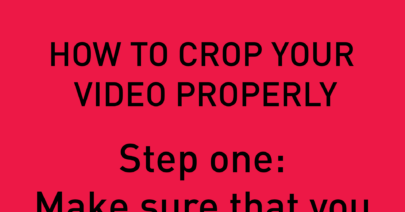
With social media, we see a lot of different videos in different aspect ratios. It can often be confusing and time-consuming to select and use the correct one, so in this blog, we will discuss the different aspect ratios that are seen on social media, choosing the correct ones and why they matter.
Platforms such as Facebook, Instagram, Twitter and TikTok utilize specific aspect ratios for their content in order to engage with the viewer and optimize their viewing experience. Uploading your content in the correct aspect ratio is part of social media best practices that we always mention, and makes your content appear more professional. Below are the four main ones and how each social media platform utilises these ratios to engage with their audience thoughtfully.
9:16 – Full portrait
Users on different platforms expect to experience and engage with content in different ways. For example, TikTok and Instagram have had tremendous success with content posted in a 9:16 frame. The 9:16 portrait ratio takes up the entire height of your phone and therefore draws the viewer in for an extended amount of time. Instagram and Facebook have both adapted the “reel” concept to their platforms, prompting a similar interface as TikTok, with videos filling an entire phone screen. This is why 9:16 should be implemented in all videos posted on TikTok, Instagram Reels and Facebook Reels.
Facebook and Instagram Stories operate in a similar way and perform best when posted in a 9:16 ratio.
16:9 – Horizontal
The 16:9 ratio is the opposite of the 9:16 ratio, and is a horizontal frame. It is most commonly used on platforms such as YouTube, and we generally see this aspect ratio the most. The wide screen appearance of this ratio is commonly used on laptops and televisions, and it fills the entire screen. However, with social media now most commonly used on the phone, most social media videos need to be adjusted away from the wide frame and converted to 9:16. Stick to 16:9 for platforms that continue to be utilized on laptops, such as YouTube.
However, filming in 16:9 is still be preferred, if you plan on using content on multiple platforms, as this ratio can more easily be converted to vertical or square ratios at a later point, especially if the person filming has these in mind when choosing the framing of the video, and recording in high enough quality.
1:1 – Square
The 1:1, or square, ratio is the most widely used ratio and it is supported by pretty much every platform. The square ratio is recommended for videos posted on Facebook feeds, LinkedIn, and Twitter. 1:1 photo content is also recommended on Instagram. Avoid posting reels on Facebook, Instagram and TikTok in 1:1 format as it typically does not engage the audience as well as 9:16.
Videos captured in 9:16 or 16:9 can usually be converted to square, 1:1, fairly easily in editing.
4:5 – Portrait
While 9:16 is a full portrait, taking up the entire screen, 4:5 is a slightly shorter vertical ratio that fits best for photos on Instagram and Facebook. With a slightly taller height than 1:1, this ratio takes up just enough surface area on a phone to engage the audience, while leaving room to read the caption and prompt engagement on the post.
We were recently sent a newsletter, that claims Facebook ads in 16:9 perform around 50% worse than square or story aspect ratios and generally, we see this reflected in our organic campaigns, too.
As the majority of social media users are on mobile, 16:9 video is just not suited for vertical mobile screens and timelines, but it is suited for YouTube.
TL;DR
- Video content should be filmed in 16:9 in 4K, which can be later converted into other aspect ratios, with framing the subject within a vertical aspect ratio in mind (don’t get too close!)
- Reels and videos for Instagram and TikTok should be in 9:16 ratio to fill the screen
- For those of you who are limited on time, the easiest way of producing video content is having everything as 1:1 square, as this saves time and confusion over different video types. This format is accepted on most video platforms.
If you’d like to speak to us about how we can help with your upcoming projects, you can get in touch by email, phone or drop by one of our offices, and we’d be happy to discuss options and approaches to meet your goals.
 BACK
BACK